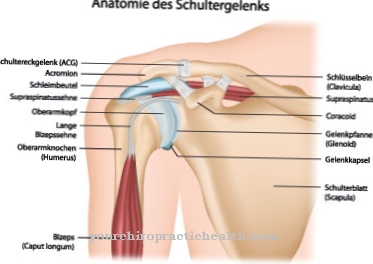The Raynaud's Syndoma is an attack-like reduced blood flow to the acra (extreme extremities) as a result of vasoconstriction (vascular cramps), which affects women four to five times more often than men. Depending on the respective form of the disease, Raynaud's syndrome can be treated well and has a good course.
What is Raynaud's Syndrome?

© Snowlemon - stock.adobe.com
As Raynaud's Syndrome are called attack-like ischemic states (reduced blood flow) caused by vasoconstrictions or vasospasms (vascular cramps), which mainly affect the arteries of the fingers and toes.
The seizures are characterized by ischaemia (pallor as a result of reduced blood flow), later cyanosis (bluish skin changes) and painful reactive hyperemia (excessive accumulation of blood) as a result of the irritation of vascular sections.
In the further course, Raynaud's syndrome is also accompanied by damage to the vascular walls such as a thickening of the intima (innermost layer of the vascular wall) and / or a capillary aneurysm (vessel expansion) with subsequent necrosis (cell death) and gangrene (self-dissolution of dead tissue).
In principle, two forms of Raynaud's syndrome are differentiated. While primary Raynaud's syndrome cannot be traced back to an underlying disease, secondary Raynaud's syndrome is associated with certain diseases such as thrombangiitis (chronic inflammatory vascular disease), scleroderma (connective tissue disease) and trauma (e.g. work with a jackhammer) or intoxication (e.g. heavy metals, certain medications).
causes
The causes of a primary Raynaud's Syndrome have not yet been conclusively clarified. The disease is probably based on a genetic predisposition to vasospastic diseases, since in many cases it can be associated with other diseases caused by vascular spasms such as migraines or angina pectoris (Prinzmetal's angina).
The involvement of hormonal factors in the manifestation of primary Raynaud's syndrome is also discussed. Secondary Raynaud's syndrome, on the other hand, is due to various diseases that cause Raynaud's syndrome to manifest. About 40 underlying diseases (including thrombangiitis obliterans, collagenosis, rheumatoid arthritis, arteriosclerosis, cryoglobulinemia, cold agglutinin syndrome) are known that can trigger secondary Raynaud's syndrome.
In addition, certain medications (beta blockers, ergotamine), excessive drug and nicotine consumption, and poisoning with heavy metals or vinyl chloride can cause secondary Raynaud's syndrome.
Symptoms, ailments & signs
Raynaud's syndrome manifests itself in attacks of cold or (emotional) stress. During an attack like this, discoloration of the skin is symptomatic, especially in the hands and feet. In rare cases, the nose, ears, forehead, and chin are also affected.
In pregnant women, the nipples can also be affected in very rare cases. Most often it is a white discoloration or a blue discoloration (cyanosis) of the skin. In other cases a two-phase discoloration can be observed, from a white discoloration to a blue discoloration.
The discoloration of the skin can also be observed as a tricolor phenomenon, in which first a white discoloration, then a blue discoloration and finally a red discoloration occurs. The red discoloration is explained by increased blood flow to the skin (hyperemia), which is usually associated with a tingling or knocking sensation.
The Raynaud attack can last from a few minutes to an hour. Pain or a tingling sensation may occur during the coloring process. The colorations can appear symmetrically (primary Raynaud's syndrome), here especially on the index finger, middle finger, ring finger and little finger, or asymmetrically (secondary Raynaud's syndrome). In a few cases, the circulatory disorders can lead to secondary damage, for example necrosis of the skin, i.e. the death of individual cells.
Diagnosis & course
A Raynaud's Syndrome can usually already be diagnosed on the basis of the characteristic symptoms such as pain and discoloration as a result of insufficient blood flow. A symmetrical pattern of involvement of the second to fifth finger indicates primary Raynaud's syndrome.
If an attack is provoked by exposure to cold (ice water), relief can be achieved by adding warmth or vasodilating nitroglycerin. If, on the other hand, there is an asymmetrical pattern of involvement in individual fingers and if the supply of heat and / or nitroglycerine cannot reduce symptoms, then it is more likely to be secondary Raynaud's syndrome.
In addition, the blood flow to the affected fingers or toes can be checked as part of an oscillograph, while Doppler sonography enables statements to be made about occlusions or constrictions in the vessels. The course and prognosis are very good in primary Raynaud's syndrome. In secondary Raynaud's syndrome, the course depends largely on the underlying disease.
Complications
If the disease is severe, the end links of the toes and fingers are no longer adequately supplied with oxygen. This can cause the tissue to become diseased or even die. As a result, the fingertips or even entire fingers have to be amputated.
If the cramps persist for a long time, this also leads to vascular damage in the long run. If the disease occurs as a result of scleroderma, there is also the risk of permanent changes in the blood vessels. Here, too, the affected tissue must be amputated. In the case of severe symptoms, drug therapy is required, which is always associated with complications. If glycerol trinitrate is prescribed, the so-called "nitrate headache" can occur.
When using it for the first time, there is also the risk of a drop in blood pressure, an increase in pulse, dizziness and feelings of weakness. Occasionally, allergic skin reactions occur or the patient suffers a collapse. A serious complication is peeling rubella addiction. This severe skin reaction occurs in isolated cases and often leads to the loss of hair and nails. If an infusion - e.g. with prostaglandins - is necessary, this can be associated with infections, injuries and occasionally with the development of thromboses.
When should you go to the doctor?
Since Raynaud's syndrome is an incurable disease, a doctor must always be consulted with this disease. There is no self-healing, whereby the complaints can only be treated symptomatically and not causally. The earlier treatment of the disease is initiated, the higher the probability of a positive course of the disease.
A doctor should be consulted if the affected person suffers from discoloration of the skin due to Raynaud's syndrome. These occur above all in severe stressful situations, where they can also be triggered by heat or cold. The skin can also turn blue. If these symptoms occur over a longer period of time, it is essential to consult a doctor. As a rule, disorders of the blood circulation also indicate Raynaud's syndrome and should always be examined by a doctor. Raynaud's syndrome can be examined and treated by a general practitioner or a dermatologist.
Treatment & Therapy
The therapeutic measures for a Raynaud's Syndrome can only aim to reduce the existing symptoms, since the disease itself cannot be cured. In the case of Raynaud's syndrome, physical measures, systemic and topical (locally) applied drugs as well as acupuncture and alternative healing methods are used.
In addition to providing information on prophylactic measures such as wearing gloves at an early stage or using pocket warmers to avoid exposure to the cold, which would worsen the symptoms of primary Raynaud's syndrome, training of the finger muscles is recommended. In addition, if you are taking medication that can cause Raynaud's syndrome (beta blockers, certain antidepressants, hormones, ergotamines), you should consider changing your medication.
As part of a drug therapy for Raynaud's syndrome, ACE inhibitors and calcium antagonists (calcium antagonists such as felodipine, nifedipine, amlodipine) are administered, especially in the case of severe seizures that are already frequent;
In addition, nitroglycerin can be applied topically to relieve symptoms in severe seizures. In the advanced stage of secondary Raynaud's syndrome, prostaglandins (iloprost, alprostadil) can be infused intravenously in order to avoid or treat necrosis.
A study was also able to show that traditional Chinese acupuncture procedures can lead to significant improvements in the severity and frequency of the seizures in primary Raynaud's syndrome.
prevention
As the causes of a primary Raynaud's Syndrome are not known, there are no direct preventive measures. However, certain factors that can trigger a manifestation or new seizures should be avoided. These factors include, for example, avoiding exposure to the cold, abstaining from nicotine as well as reducing work with heavily vibrating equipment (e.g. jackhammer). Early and consistent treatment of the underlying disease may prevent secondary Raynaud's syndrome.
Aftercare
Regular checks once a year by the treating doctor or in a specialist outpatient clinic are mandatory. A competent person should treat wounds immediately so that they heal well. Conscientious follow-up care is essential, especially in the case of newly developed wound healing disorders. Patients with or previously struggling with Raynaud's syndrome should conscientiously follow all recommended precautions.
Ideally, this will prevent the symptoms from recurring. Aftercare also includes continuing to eat as healthily as possible. It is important to use caffeine-containing luxury foods sparingly. A diet rich in vitamins, on the other hand, can protect the vessels. At the same time it is important to refrain from smoking and to avoid smoky rooms. The same goes for stress. Exercise is beneficial for recovery as it stimulates blood flow.
It is advisable to take pain relievers and cold medication only after consulting a doctor who has been informed about the patient's medical history, as these agents could contain substances that constrict the blood vessels. Those affected should always wear warm gloves when it is cold and it is better not to attack cold objects unprotected.
If, despite all precautionary and follow-up measures, a Raynaud attack occurs again: As an immediate measure, hold your hands under warm water or in your armpits, massage and move them. In this way, the vessels quickly expand again.
You can do that yourself
In Raynaud's syndrome, the first thing to do is to avoid the triggers. The hands and fingers must be specially protected from cold and wet. In winter it is important to always wear well-insulating gloves, e.g. with neoprene layer. Only heated gloves or pocket warmers may help. Pressure on the palm of the hand increases symptoms. This occurs e.g. when cycling or working with your hands in the cold. If such triggers cannot be avoided, preventive measures such as finger exercises, movement of the arms and hands and regular pressure relief can help.
Vascular constricting substances should be avoided. This mainly includes nicotine, but also some medications. It is therefore extremely important to inform the doctor about the disease, even if the current symptoms apparently have nothing to do with Raynaud's syndrome.
Overall, a healthy lifestyle also improves vascular health. The reduction of stress and restlessness, as well as a balanced, vitamin-rich diet have a protective effect and can delay the progression of the disease. Sport with endurance training is particularly important, as it optimizes blood flow throughout the body and has a calming effect on the nervous system.
None of the above measures cannot cure the disease, but they can improve the quality of life and delay the progression.


.jpg)










.jpg)

.jpg)
.jpg)











.jpg)